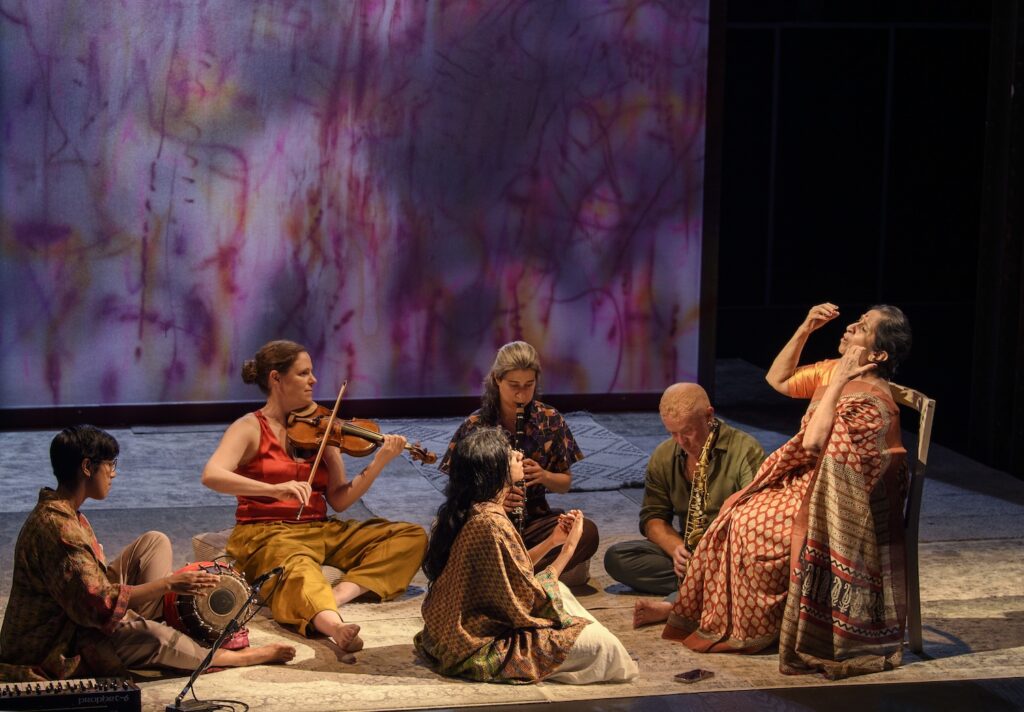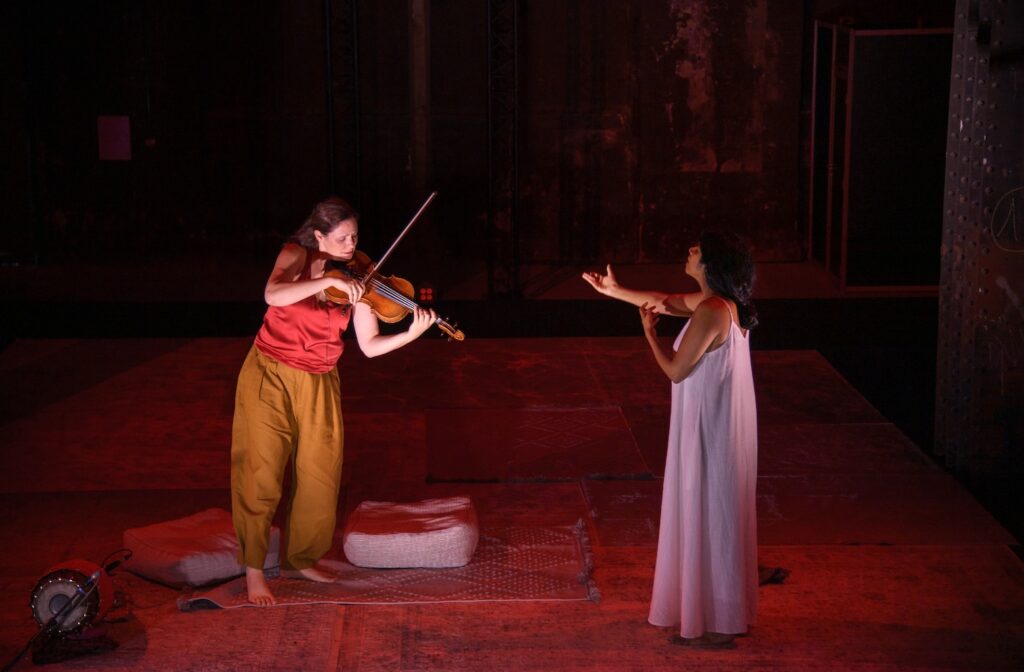Or was it ten? One lost count. But that was early in the evening of the telling of this sort of parable with accompanying instrumental improvisation by six earnest musicians.
Two voices told a story, veiled in a flowery, Southern Indian language (definitely not Modi’s Hindi!), with added, projected English text from time to time, occasionally spoken other times. The English supertitled in French.
The story seemed to tell of the rape of a young girl (a much discussed topic just now in India). Over the evening her spirit is restored by her grandmother, the (or a) king having dispatched soldiers into the forest in search of this wisdom. Or some such.
We all prayed together during the exposition of the jewels, though we didn’t really, given that the chanted refrain was softly broadcast, as if it were we, chanting. We briefly prayed together again in the closing moments of the evening that went beyond its announced duration of one and one half hours.
The masterminds of this collaborative project for voices and instrumentalists are Israeli born, U.S. formed ethno-musician Sivan Eldar, now in residence at Paris’ ICRAM (Institute for Research and Coordination in Acoustics/Music), working with U.S. born, India raised, American ethno-musician Ganavya Doraiswamy, a founder of the We Have Voice Collective.

The two women were commissioned by Arles’ LUMA Foundation (luma = light) and the Aix Festival to create this piece of live conceptual art based on a fifth century Chinese fresco. There were three performances at this Arles arts campus before the three performances as part of the Aix Festival. Such a conceptual, collaborative, improvisatory art piece does not sit comfortably or convincingly within the performative perimeters of the Aix Festival.
The sole performative aspect of The Nine Jewelled Deer was its staging by 67 year old American wunderkind Peter Sellars. Mr. Sellars made use of his usual collaborators, Camille Assad for costumes and James F. Ingalls for lighting to establish the feeling of a sort of improvised visual space.
The instrumentalists were clothed as if they had just happened by the Jeu de Paume theater on a hot afternoon, the rape victim was casually dressed, when not donning elements of Indian attire, the grandmother in traditional garb. The bare stage exhibited only a few strategically hung or placed lighting instruments, as the production was first staged in Arles in an open, workshop/gallery space, not a theater.
A few screens alternated prominences behind the performers. They changed colors from time to time, when not displaying colorful, projected images created by Ethiopian born, New York painter/visual artist Julie Mehretu, a 2006 MacArthur Fellow (the so-called American “genius” award).

Mr. Sellars, once a MacArthur Fellow as well, created a few memorable stage pictures of the performers within the visual field, and created a few interesting staging moments within the call-and-response structure of Southern Indian music. He placed his musicians and voices always with intense, knowing respect for their parts in expounding and enriching the conceptual precepts of Mmes. Eldar and Doraiswamy.
The voices were Ganavya Doraiswamy (who also played the guitar) as the girl (lead photo), and the venerable Indian Carnatic [the music system of South India] singer/humanitarian Aruba Sairam as the grandmother. The instrumentalists were Israeli violinist Nurit Stark, American cellist Sonia Wieder-Atherton, Israeli clarinetist Dana Barak, New Zealand saxophonist Hayden Chisholm, American percussionist Rajna Swaminathan, French live-electronic musician Augustin Muller, responsible as well for the ICRAM generated sounds that grounded the improvisations. All musicians boast impressive educational and avant-garde arts credits.
The projected, interpolated English language words were composed by Lauren Croft, a New York Times best selling author who lives in Florida.
Michael Milenski
Théâtre du Jeu de Paume, Aix-en-Provence, France, July 16, 2025
All photos copyright Ruth Walz, courtesy of the Aix Festival